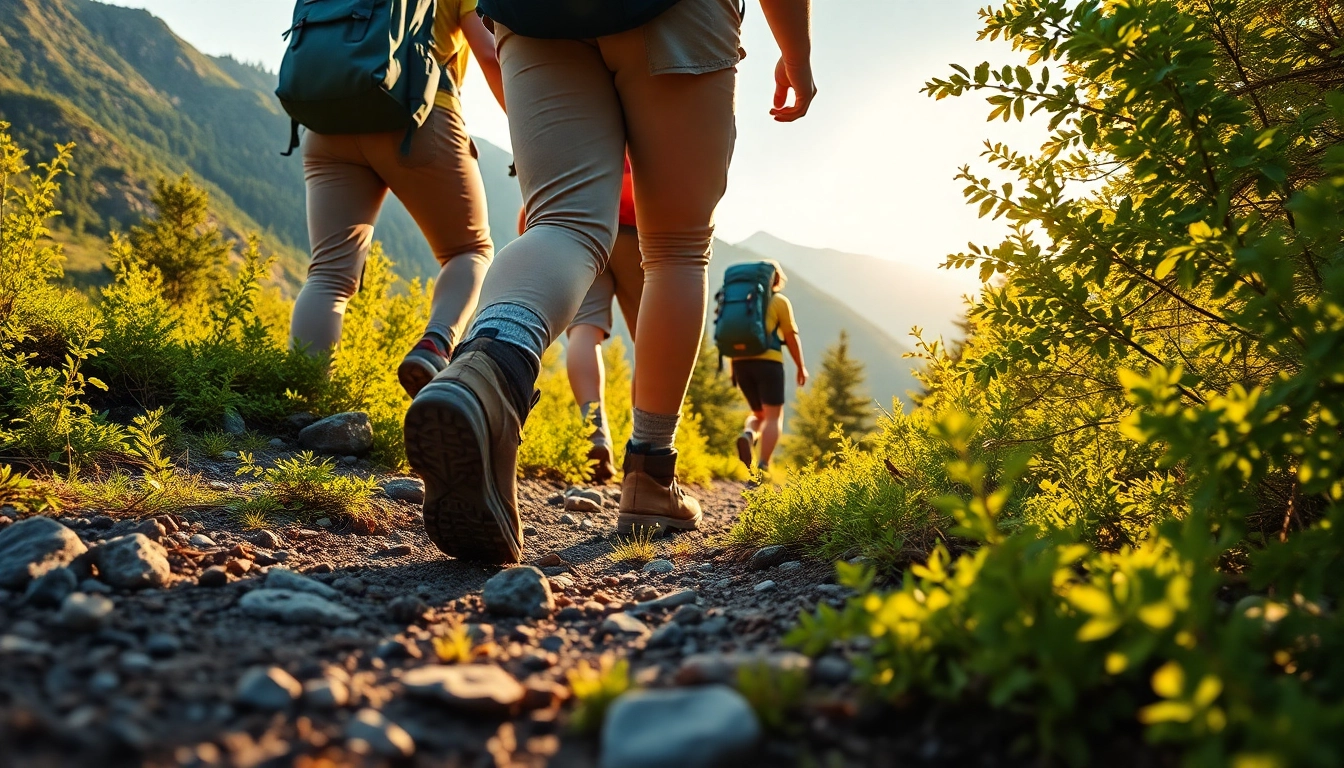Foundations of Hiking: Understanding Its Importance and Variations
Hiking is more than just a recreational activity; it embodies a timeless connection between humans and nature, offering numerous physical, mental, and emotional benefits. Whether you’re a beginner or an experienced trekker, understanding what defines hiking and how it differs from related outdoor pursuits is essential for maximizing your experience. As the activity continues to grow in popularity across Indonesia and globally, it’s important to grasp its core principles, health benefits, and different types to tailor your adventures effectively. For those eager to explore Indonesia’s stunning landscapes, this guide will reveal why hiking is an indispensable part of outdoor culture and how to start your journey safely and meaningfully.
To deepen your knowledge and find prime hiking destinations, visit hiking in Indonesia’s diverse terrains—from lush mountains to pristine beaches—making it an adventure accessible to all levels.
1.1 What Defines Hiking and Its Health Benefits
At its core, hiking is a long, vigorous walk primarily on trails or footpaths through varied natural environments. Unlike casual strolling, hiking often involves traversing uneven terrain, inclines, and natural obstacles, demanding physical effort and stamina. It develops strength, endurance, and flexibility while promoting cardiovascular health. Regular hiking sessions have been linked to reduced risks of heart disease, improved muscle tone, weight management, and better bone density.
Beyond physical health, hiking is proven to alleviate stress, combat depression, and enhance mental clarity. The natural exposure to green spaces boosts mood, mindfulness, and emotional resilience. Scientific studies, such as those conducted by national parks and health organizations, consistently demonstrate these benefits, making hiking a recommended activity for holistic wellness.
Historical and Cultural Context of Hiking
Emerging in Europe during the 18th century as a leisure pastime, hiking has evolved into a universal activity embraced worldwide. Its affordability and minimal requirements have contributed to its widespread popularity, especially in countries like Indonesia, where abundant natural landscapes provide ideal settings for both casual walks and strenuous adventures. Modern gear developments, safety protocols, and guided treks have made hiking accessible and enjoyable for everyone.
1.2 Differentiating Hiking, Trekking, and Walking
Although often used interchangeably, hiking, trekking, and walking possess distinct characteristics that influence preparation, equipment, and experience.
- Walking: A leisurely activity typically on flat, paved, or well-maintained surfaces like sidewalks or park pathways. It’s suitable for daily routine, light exercise, or exploring local areas.
- Hiking: A vigorous activity on trails or footpaths in natural settings, involving uneven terrain, slight to moderate inclines, and varying conditions. It is often undertaken for recreational, physical, or spiritual reasons and demands suitable footwear and safety measures.
- Trekking: A more intensive multi-day journey through remote or challenging terrains, such as mountains, jungles, or rugged paths. Trekkers usually carry their gear, requiring advanced planning, gear, and physical conditioning.
Recognizing these differences helps in choosing the right activity aligned with your fitness level, available time, and adventure goals. For Indonesia’s diverse topography, both hiking and trekking offer unique challenges and rewards.
Key Considerations When Choosing Your Activity
Factors such as terrain difficulty, duration, required gear, and personal fitness levels should guide your decision. For beginners, gentle hikes in national parks or coastal trails are ideal, whereas seasoned adventurers might opt for multi-day mountain treks.
1.3 Common Equipment and Safety Essentials for Hikers
Proper gear is pivotal for a safe and enjoyable hike. While equipment varies based on terrain and duration, some essentials remain universally recommended.
- Footwear: High-quality hiking boots with ankle support and good grip are vital for navigating uneven terrain and preventing injuries. For shorter or easier trails, trail-specific shoes can suffice.
- Clothing: Layered clothing suitable for weather conditions, moisture-wicking shirts, waterproof jackets, and sun protection gear like hats and sunglasses.
- Navigation Tools: Topographic maps, compasses, or GPS devices to prevent getting lost, especially in remote areas.
- Hydration & Nutrition: Sufficient water, energy bars, and electrolytes to maintain stamina during the hike.
- Safety Items: First aid kits, flashlights or headlamps, multi-tools, and emergency communication devices.
Safety Practices and Precautions
Always inform someone about your route and expected return time. Check weather forecasts and trail conditions before departure. Respect wildlife and natural habitats, adhere to Leave No Trace principles, and carry appropriate gear tailored to environmental challenges.
For more insights on hiking gear, visit Wikipedia’s Hiking equipment page for detailed equipment guides.
2. Planning Your Hiking Trip: Preparation and Routes
2.1 Selecting Appropriate Trails in Indonesia and Beyond
Indonesia boasts a plethora of renowned hiking destinations, from the volcanic landscapes of Mount Rinjani in Lombok to the lush rainforests of Borneo. To select suitable trails, consider factors like difficulty level, scenery, distance, and personal fitness. For beginners, accessible national parks such as Gunung Gede Pangrango or Bali’s Mount Batur provide manageable options with well-marked trails and facilities.
Experienced hikers seeking challenge can explore remote areas like the Ijen Crater or the peaks of Papua. Planning through trusted sources, local guides, or official park websites ensures safety and satisfaction.
Factors to Consider When Choosing a Trail
- Trail length and duration
- Elevation gain and terrain difficulty
- Weather conditions and seasonality
- Availability of facilities or guides
- Local regulations and permits
2.2 Preparing Gear: Footwear, Clothing, Hydration, and Navigation
Preparation begins with assembling the right gear tailored for your chosen trail. Invest in durable, comfortable footwear appropriate for the terrain. Waterproof and breathable jackets, moisture-wicking layers, and sun protection are key clothing considerations.
Hydration strategies include carrying sufficient water and, if necessary, portable water purification devices. Navigation tools such as GPS watches, mobile apps designed for hikers, and traditional maps enhance safety, especially in areas with poor signal.
Gear Checklist for a Typical Hiking Trip
- Sturdy hiking boots or shoes
- Weather-appropriate clothing
- Water bottles or hydration packs
- Navigation devices (GPS, compass, map)
- First aid kit
- Snacks and energy bars
- Sun protection (hat, sunglasses, sunscreen)
- Emergency communication devices
2.3 Assessing Difficulty Levels and Environmental Conditions
Understanding trail difficulty is crucial for a successful hike. Difficulty ratings typically consider terrain ruggedness, elevation gain, distance, and technical requirements. Recreational parks often classify trails as easy, moderate, or difficult.
Environmental factors such as weather patterns, trail maintenance, and wildlife can influence hike safety. For instance, monsoon seasons increase risks of mudslides or flash floods, while high temperatures require extra hydration and sun protection.
Strategies for Effective Planning
- Research recent trip reports or trail conditions
- Prepare contingency plans for bad weather
- Adjust your itinerary according to your skill and fitness level
- Stay informed about environmental hazards and local advisories
3. Practical Hiking Techniques for All Levels
3.1 Trekking Uphill, Downhill, and on Uneven Terrain
Mastering proper techniques enhances safety and reduces fatigue. When ascending, lean slightly forward, shorten strides, and use your arms for balance. For downhill sections, take smaller, controlled steps to prevent slips and strain. Navigating uneven terrain requires watching your foot placement, utilizing trekking poles for stability, and maintaining a steady pace.
Practical Tips
- Keep your weight centered over your feet
- Engage core muscles for balance
- Use trekking poles to reduce joint impact
- Take frequent breaks to conserve energy
Proper technique not only conserves energy but also minimizes injury risks, essential for both novices and seasoned hikers.
3.2 Navigating Trails Safely and Conserving Energy
Navigation involves following trail markers, maps, or GPS devices, and recognizing natural landmarks. Stay on designated paths to protect the environment and avoid getting lost. Conserve energy by pacing yourself, maintaining a steady rhythm, and taking scheduled rest breaks.
Energy Conservation Techniques
- Start slow and build momentum
- Maintain a comfortable pace suited to your fitness
- Stay hydrated and nourished
- Use efficient walking techniques to reduce fatigue
These practices ensure you complete your adventure safely and with maximum enjoyment.
3.4 Wildlife and Natural Feature Spotting
Indonesia’s rich biodiversity offers opportunities to observe unique flora and fauna, including exotic birds, primates, and endemic plant species. Approach wildlife respectfully, keeping a safe distance and avoiding disturbances. Natural features like waterfalls, volcanic craters, and diverse ecosystems enhance the scenery and deepen your connection with nature.
Guides with ecological expertise can enrich your experience through educational insights about local ecosystems and conservation efforts.
4. Enhancing the Hiking Experience: Tips and Best Practices
4.1 Leave No Trace Principles and Eco-friendly Practices
Responsible hiking mandates preserving nature’s integrity. Follow the Leave No Trace principles, which include packing out all trash, minimizing campfire impacts, respecting wildlife, and staying on marked trails. These actions ensure natural beauty remains for future generations and safe habitats for animals.
In Indonesia’s protected areas, adhere to park regulations and support local conservation initiatives.
4.2 Staying Motivated and Managing Challenges
Maintaining enthusiasm during hikes involves setting clear goals, enjoying the scenery, and sharing with fellow hikers. Be prepared to face weather changes, fatigue, or navigational setbacks by staying flexible and positive. Incorporate mindfulness techniques to enhance overall experience and resilience.
Strategies to Overcome Common Challenges
- Break your hike into manageable segments
- Celebrate small achievements along the trail
- Stay hydrated and nourished for sustained energy
- Connect with local guides or groups for support
4.4 Capturing Memories: Photography Tips for Hikers
Nature offers endless photographic opportunities. Use a wide-angle lens for landscapes, a macro for flora, and a smartphone or camera to capture the moment. Early morning and late afternoon provide softer light, ideal for vivid images. Practice patience to wait for the perfect shot, and respect trail rules regarding photography.
Preserving your journey visually encourages reflection, sharing, and inspiring others to explore responsibly.
5. Measuring Success: Tracking Progress and Long-Term Benefits
5.1 Using Technology: Apps and GPS Tools
Modern technology offers invaluable support for hikers. Apps like AllTrails, ViewRanger, and maps on smartphones help plan routes, monitor progress, and locate nearby facilities. GPS devices enhance safety in remote areas. Long-term tracking helps users monitor improvements in endurance, strength, and overall well-being.
Recommendations for Effective Use
- Download offline maps in case of signal loss
- Set waypoints and track your hike duration and distance
- Analyze data post-hike to assess fitness progress
- Share your routes and achievements with community groups
5.2 Setting Achievable Goals for Physical and Mental Health
Define clear, realistic objectives—whether completing a particular trail, increasing daily steps, or enhancing mental clarity. Use SMART criteria (Specific, Measurable, Achievable, Relevant, Time-bound) to guide progress. Regular hiking fosters discipline, improves cardiovascular health, and cultivates mindfulness.
Tracking these goals through journals or apps can motivate continued engagement and provide a sense of achievement.
5.4 Sharing Your Hiking Journey with Community
Connecting with local or online hiking communities fosters camaraderie, provides shared experiences, and encourages responsible outdoor ethics. Platforms like social media groups, local clubs, or environmental organizations enable hikers to exchange tips, plan group adventures, and promote conservation awareness.
Participating in community projects or trail clean-ups amplifies your impact beyond personal benefits.

